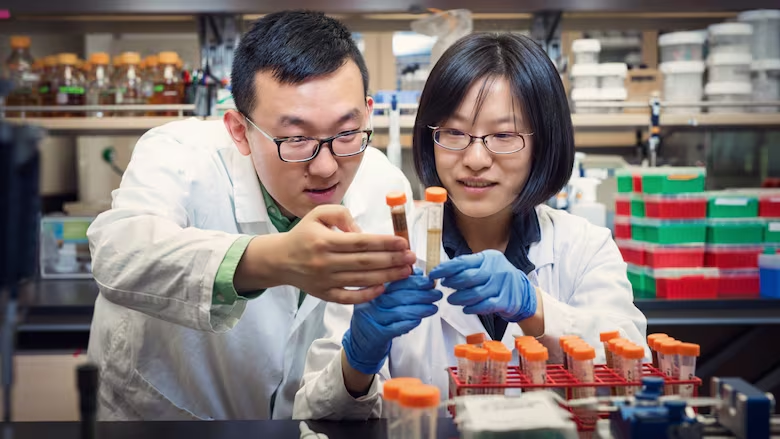Is chocolate really good for you? UBC scientists make new tool to measure antioxidants
New, quicker method will help identify steps in manufacturing that cause antioxidants to drop

Every chocolate lover wants the headlines about antioxidants in chocolate to be true.
For better or for worse, determining just how much of the disease-fighting molecules are contained in this popular treat may be getting a little easier.
Researchers from the University of British Columbia say a new tool they've made will help determine those antioxidant levels much more quickly and reliably than has been possible so far.
"Our method predicts the antioxidant levels in chocolate in under a minute, compared to the industry standard that can take several hours or even days," said Xiaonan Lu, an assistant professor at UBC's faculty of land and food systems.
Lu developed the system along with PhD candidate Yaxi Hu.
Their new system "can do a very rapid and reliable screening of a lot of samples in a short time period," Lu told CBC News.

Antioxidant loss
Cocoa beans are rich in antioxidants, but the hitch is that the process to turn them into chocolate bars diminishes those disease-fighting compounds.
"During the whole chocolate processing stage there will be a lot of loss during every single step — for example, the fermentation, the drying — so those will be the key parameters that affect the final antioxidant levels in the chocolate," Lu said.
As most chocolate lovers know, milk chocolate has lower levels of antioxidants than dark because the percentage of cocoa beans is lower when milk and other additives are introduced.
But Lu said the new method of measuring antioxidants will help identify and refine the process of making chocolate, with the hope of adapting it to optimize antioxidant levels.
"This is only the first step," said Lu. At this stage, the food scientists have established a process for testing finished chocolate bars.
"But, starting from there, we're going to go to the raw cocoa beans and test for each step in the chocolate production, because we want to know which step is most critical for the antioxidant loss."
Funding chocolatier
While this research project is funded primarily by the federal government's Natural Sciences and Engineering Research Council (NSERC) and the non-profit Mitacs, it was an inquiry and offer of funding from a Vancouver-area chocolatier that got it underway.
"The company is a small local company in West Vancouver," said Lu.
"The CEO of the company has a lot of interest to know the level and also the state of the antioxidants in the chocolate products, because they do the manufacturing of the chocolate from the beginning: from the harvesting of the raw cocoa beans to the final chocolate products.
Whether increasing antioxidants levels in something like chocolate really has any measurable clinical benefit I think is an open question.- Timothy Caulfield, University of Alberta
"And he really wanted to know how to control, how to maximally maintain the level of the antioxidants during the manufacturing.… He's a big fan of the antioxidants, so I think that's the initial motivation."
Don't splurge yet
Timothy Caulfield, a professor at the University of Alberta's faculty of law and school of public health, studies how industry funding affects scientific research. He told CBC News that industry money is "something we know has an impact on both the science and how the results are presented."
Although Caulfield is a chocolate lover who would be delighted to know the health benefits are real, he said that really hasn't been established yet.
"The whole concept behind antioxidants and whether increasing antioxidants levels in something like chocolate really has any measurable clinical benefit I think is an open question. And it's almost like it's being used as marketing strategy," he said.
Lu himself cautions that chocolate has to be approached in a balanced way. He said consumers and most food industry experts "totally agree that the digestion of antioxidants are very beneficial to consumers."
"But on the other hand … there's a relatively high level of fat."
Really what they're trying to do is leverage perceptions of health and create a "health halo" around the product.- Timothy Caufield, University of Albert law professor
He also pointed out that Canada doesn't yet require companies to include the antioxidant levels on food packaging. "I know in some European countries they have this labelling of the antioxidant level in chocolate bars. That's not the situation in North America."
A 'health halo'
Speaking generally about chocolate marketing, Caulfield said "really what they're trying to do is leverage perceptions of health and create a 'health halo' around the product. That 'somehow because it has antioxidants I can eat more chocolate' — which I'm all for, by the way."
In what could be considered another effort to put that halo on chocolate, this week Nestlé scientists announced that the company had found a way to decrease the sugar in chocolate by as much as 40 per cent by hollowing out the sugar crystal to deliver sweetness in smaller amounts.
Caulfield said chocolate is "a really good example" of conflicting data about health benefits of foods. "Chocolate's good for you, chocolate's bad for you, chocolate is neutral — you hear all these conflicting stories."
The reality is that no one food should be crowned a so-called superfood, said Caulfield. "I think it's all about eating a balanced diet, stuff that we've known for decades. We're talking lots of fruits and vegetables, whole grains, healthy proteins: there is no magic out there."

